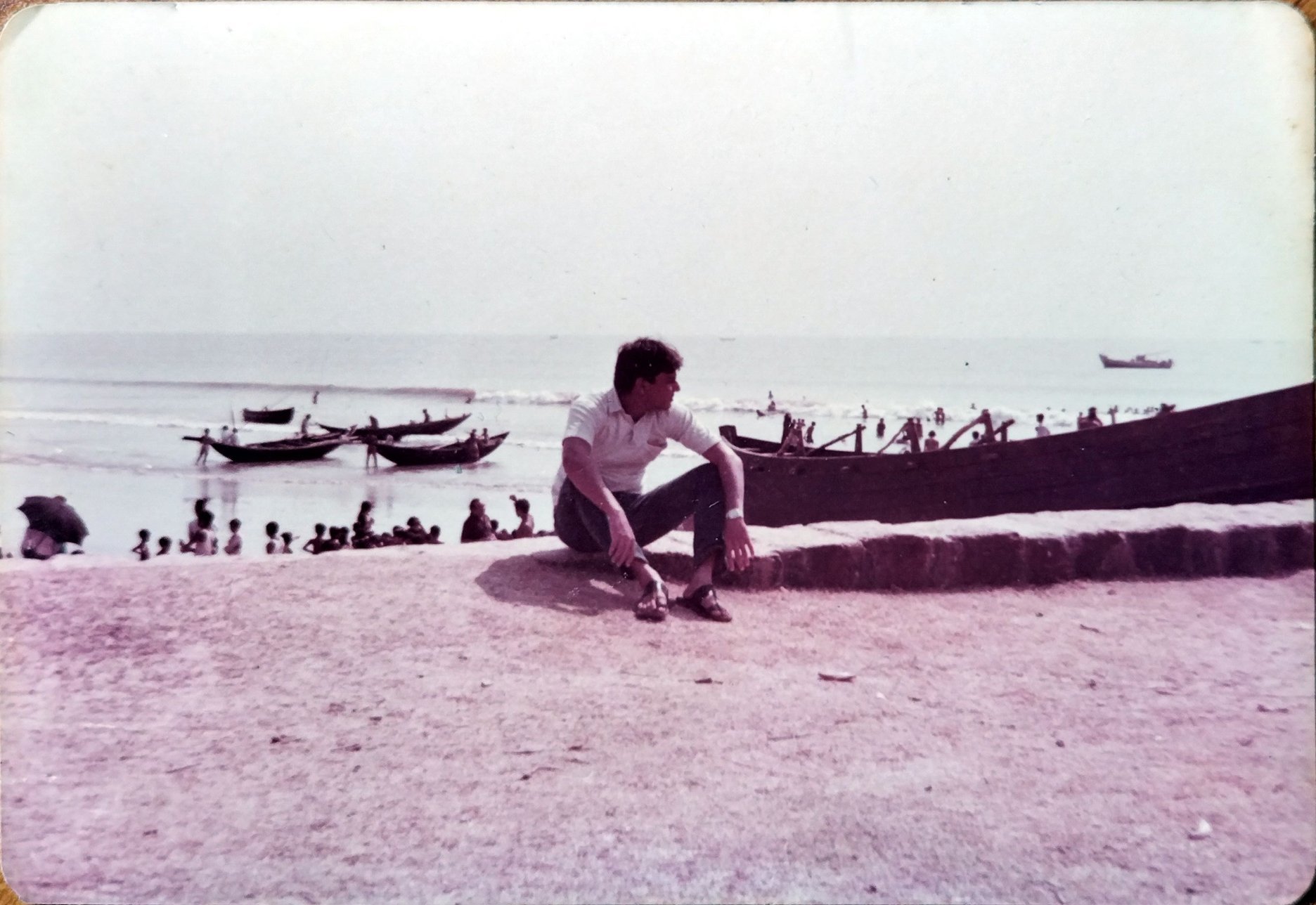Eating Boat Biryani in the Lakshadweep

Rucha Karkarey writes about Boat Biryani, a staple food of the fishermen of Lakshadweep, made with fresh tuna, the island’s most celebrated fish.
I woke up one morning with an insatiable craving for Boat Biryani. Many weeks into the COVID-19 lockdown, the local seafood markets were still closed, and I was suffering from severe seafood withdrawal. I poked about my pantry and found a can of tinned tuna that my husband had squirrelled away, without my noticing. “Sustainably caught in the Maldives using pole-and-line fishing,” the label read. I took a deep breath and laid down my scruples about tinned fish. (What is fish, if not fresh?) Today, I needed this.
I set a pan on the stove and began with sautéing some onions and crushed garlic. The aromas whirled around me like a dervish, transporting me back to an unforgettable boat ride almost three years ago on Nasarikka’s little fishing vessel, somewhere in the azure seawaters off Lakshadweep, is where I first feasted on fresh fish biryani. ‘Boat biryani’ as the locals call it, is a staple food of the island fishermen that voyage over days in the ocean, in search of catch.
The return journey from Bitra, one of the northernmost islands in Lakshadweep, will take us just over eight hours. I often travel between the isles on small fishing boats, with my colleagues, as part of my PhD fieldwork. Today, as we sit half-dazed under the sweltering sun, the vessel suddently veers left. We awake to a frenzy of activity around us; Rauf, at the bow, is manically pointing into the distance; Nasarikka, our skipper, cranks it up a gear and moves the boat full speed ahead. Jafer manoeuvres the 8-ft poles fastened to the side of our boat. In the distance, we can see a flock of sooty terns (Onychoprion fuscatus) frantically dive-bombing the water. A school of tuna has been spotted.
Tuna fisheries in the Lakshadweep islands have a glorious history. They sprouted in the southernmost island of Minicoy, where a 1000-year-old, offshore pole-and-line fishery with origins in the Maldives, was traditionally practised. The Maldivian pole-and-line fishery is considered highly sustainable, because of low levels of bycatch (i.e. untargeted marine life like sharks and turtles are not harmed in the process), the natural limits placed by this form of labour-intensive practice (i.e. a fisherman catches fish one at a time using one hook and one line), and the livelihood it creates for fisherfolk in developing nations. This fishery has revolutionised the seafood industry, as companies scramble to buy into this practice to meet sustainability goals. To emulate the commercial success of Minicoy’s fishery, the local Fisheries Department introduced offshore pole-and-line fishing to the other islands in Lakshadweep, in the 1960s. Since then, pole-and-line fishing for tuna has remained the dominant form of fishing in these islands. In addition to forming the commercial backbone of the economy, tuna also grew in cultural significance. Fishing for tuna developed into a family activity — relatives and friends were involved at different stages of the operation, from fishing to processing and selling the catch. Young boys honed fishing skills on their father’s and uncle’s boats, and women conjured up different ways to process tuna on land. Today, most people in the community play a part in this enterprise.
As we approach the tumult, Jafer and Rauf steady themselves on the awning of the boat, poles firmly in hand. Beneath us, the water churns a frothy white as thousands of tuna attack a shoal of sardines. Birds dive like missiles into the glimmering sea, victoriously emerging moments later with silvery fish in their beaks. Jafer dips the other end of his pole into the water, and gyrates the 2-metre long fishing line attached with a barbless hook. In this feeding frenzy, tuna will bite at anything. In a most effortless sleight of hand, he flings a fish to the back of the boat. Within 10 minutes, five skipjack tunas (Katuswamis pelamis) with iridescent bodies and black lateral stripes convulse violently at our feet. Nasirikka leaps forward and administers a severe blow to their skulls, instantly rendering them unconscious. “Ithu nangala firakaarakkbayndi" (These are for our families), he says in Jasree, placing four limp fish in a gunnysack. Then he sets one aside. "Ithu boatu biriyaanik bayndi" (This is for boat biryani), he smiles.
Tuna is the most celebrated fish in Lakshadweep, its versatility apparent in the sheer diversity of recipes it lends itself to; more so than any other fish. Lakshadweep even holds an annual ‘Tuna Festival,’ where each island competes to outshine the other’s culinary masterpieces featuring this fish. Smaller species of tuna are cooked in brine and sundried to make maas (tuna jerky). Maas is the largest island export, but is also eaten locally in eclectic ways. Flaked maas is used to thicken and flavour curries. It is also used to make maas appams — small morsels of fried dough filled with a savoury mixture of grated tuna and coconut. A delicious afternoon pick-me-up, maas is eaten as a lazy snack together with slices of freshly cut coconut and a glass of kattan chai (black tea). The larger yellowfin tuna (Thunnus albacares) is cut into chunks and stewed in curries, marinated with local masala and seared, or preserved in pickles of varying potency. But the most exquisite of them all is undoubtedly boat biryani.
On the boat, Nasirikka pulls out a plastic crate housing a paraphernalia of condiments, spices and kitchen staples. He first cuts the skipjack tuna and scoops out two ripe ovaries. He then hacks the fish into chunks, setting them aside to marinate in coconut vinegar. He husks and grates two coconuts, and collected the milk in a bowl. Next, he soaks and cleans the rice in seawater and chops a handful of onions, chillies, tomatoes and garlic. In the meanwhile, Jafer sets a few coconut shells ablaze in a makeshift stove, fashioned from an old steel bucket. We watch transfixed as Nasirikka sautées the ingredients with spices in a stockpot over the fire. Last, he adds in the rice, coconut milk and three tumblers of seawater, scooped up from the side of the boat. Placing the lid on the pot he smiles, “30 minute kond shor ready akum” (Dinner will be ready in 30 minutes). As if this wasn’t an elaborate enough meal, Nasirikka prepares some garnish; he soaks a chopped onion in vinegar, and barbecued the ovaries he had removed earlier, over the flame. He goes off to offer Maghrib, and we wait with bated breath for the biryani to cook.
Needless to say, every single bite is an explosion of flavour in our mouths, heightened by the freshness of the catch and reminiscent of the tuna’s long migration in search of a hunting ground, of its Darwinian survival over (potentially) three years and a decades-long confluence of culture and commerce that brought it to an abrupt end here in Lakshadweep. The whole experience — of the gently rolling sea, the salty breeze in our hair and the primal satisfaction of hunting our meal made this a spiritual gustatory experience like no other. George Monbiot once wrote about precisely this feeling (‘Hunter’s Pride’) in an essay, saying, “It feels to me like the opening of a hidden door, a rent in the mind through which you can glimpse a ghost psyche: vestigial emotional faculties that once helped us to survive”. I couldn’t help but think about how boat biryani was more than just survival food. A 45-minute meal that gave hardworking fishermen a brief reprieve of joy in a day that is otherwise riddled with uncertainties. Using minimal ingredients, Lakshadweep’s fishermen created a plat du jour — one prepared with the ritualistic orderliness of a priest but truly celebrates their itinerant identity.
RECIPE FOR BOAT BIRYANI
Ingredients
½ kg fresh tuna or seer fish cut into 2cm chunks (bone-in or fillets)
2 medium onions
3 green chillies
2 tbsp ginger garlic paste
2 tbsp coconut vinegar, plus extra
2 tsp red chilly powder
2 tsp turmeric
2 tsp coriander powder
1 tsp garam masala
3 tsp ghee
1 ½ cups of basmati rice (feel free to use any rice of your choice, but cook accordingly)
1 can coconut milk (fresh or canned)
Method
Marinate the fish: Clean the fish and pat dry. Mix together ginger-garlic paste, 1 tsp of salt, turmeric, coriander powder and red chilly powder and apply to the fish. Drizzle 2 tbsp of vinegar and set aside for (atleast) 30mins.
Soak the rice for 30 mins in water, then drain and keep aside.
3. In a heavy bottom pan (saucepan or casserole dish) add a tsp of ghee and shallow fry the fish pieces on both sides for less than 2 mins. Keep aside and once again drizzle with vinegar.
Fish Masala: Finely slice 1 ½ onions and chop the green chillies. In the same saucepan add 2 tsp of ghee and sauté the onions with chillies and ginger garlic paste until golden brown. Add a tsp of garam masala, turmeric, red chilly powder, coriander powder and salt to taste. Cook the mixture for 1 minute.
Cooking the Rice: Add the drained rice to this masala and mix until it combines nicely. Pour in a can of coconut milk and 2 cups of water. Boil the flavoured rice on a medium flame, uncovered, for 10-15 minutes. Stir regularly.
5-7 minutes before the rice is cooked, add the fried fish into the saucepan. Cover and boil the rice for the remaining 5-7 minutes.
While rice is being cooked, soak the remaining ½ onion in a few tsp of vinegar to use as garnish.
Serve hot with pickle and onions and dream about gently rolling seas. Enjoy!
Rucha Karkarey is a marine biologist who has spent much of her time stalking coral reef fish underwater in the Lakshadweep to understand how they respond to climate-change.
ALSO ON THE GOYA JOURNAL









